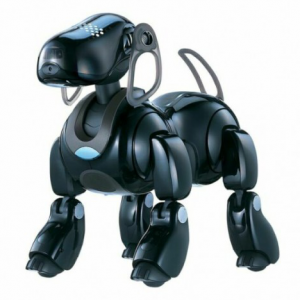Announced as a prototype in 1998 and made available to the general public in May of 1999, Sony’s AIBO line of “entertainment robots” were called “the most sophisticated product ever offered in the consumer robot marketplace,” at their induction into the Robot Hall of Fame in 2006. While many people associate the AIBO name with the beagle-like ERS-7 model (pictured here), not all models were so obviously canine in their inspiration. The ERS-210 found its design inspiration from lion cubs, while the ERS-220 shed any pretense of biomimicry with its futuristic design.
I always wanted an ERS-7, but with a $2000+ price tag, I knew the idea of owning one would never amount to more than a pipe dream. I still love the idea of robot pets and spend quite a bit of time thinking about how to strike the perfect balance between functionality, aesthetics, and price. Robots don’t require food, they don’t make messes and should actually not only clean up after themselves, but their owners, too! But most importantly to me, they should never really have to die.
I have a 7 year old Golden Retriever. If we’re lucky she’s only just now passed the midpoint of her life. Still, I often find myself thinking about what it will be like in the end: when her hips begin to fail her, or cancer or some other equally insidious disease fells her. I know that I will be heartbroken. It shouldn’t have to be like that with robot companions. It turns out that when an entire line’s fate is in the hands of a multi-national corporation whose sole concern is their bottom line, a robot pet is just as mortal as one that is flesh and bone.
Sony had sold 150,000 AIBOs by 2006 when they discontinued the 7 year-old product line. This is an astonishing feat considering both the price and the fact that even now, almost a decade later, a product like the AIBO would be considered ahead of its time. But 150,000 is a small number for a company used to moving millions of units in other divisions and product lines. While not necessarily losing money for the company, AIBO margins and sales volume weren’t enough to survive corporate restructuring in the face of Sony’s declining profits.
For eight years, Sony continued to provide both technical support and repairs for AIBOs, and their fiercely devoted owners. This ended, however, in July of 2014 when Sony announced they would no longer repair AIBOs or provide any customer support to their humans. As part of their Robitica video series, The New York Times reported on the impending extinction of the AIBO and the affect the robot dog’s mortality is having on the thousands of people that love them like family. The termination of support by Sony gave rise to third party repair people, but with production having been entirely suspended nine years ago, the sole source of parts for repairs are other AIBOs who themselves were beyond repair and made available for salvage. Obviously this is not sustainable, and many are now beginning to recognize the inevitable end is nigh.
For more, visit the The New York Times web site and watch the touching video about what will be seen as the end of an era by many, and by a relatively few, the entirely avoidable death of a cherished family pet.


2 comments
With modern small scale prototyping and production methods the repair of Sony’s Aibo is now a sustainable industry, both ourselves and other like minded repairers have sourced replacement parts for the most common failure points and have also designed/sourced new parts that don’t suffer the same failures. We have also developed repair techniques that mean we don’t have to use donor parts all the time as we can now repair and crucially restore them to near new condition. Aibo’s still live strong in our hearts and will continue to do so in our homes and our lives if we have anything to do with it 🙂
For those in need of assistance you can visit us at aibo-repairs.com